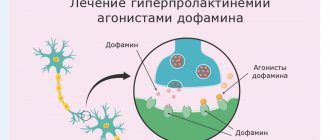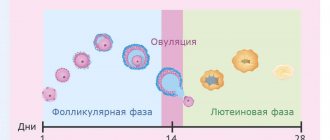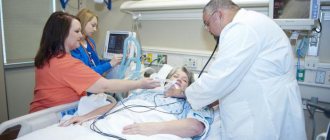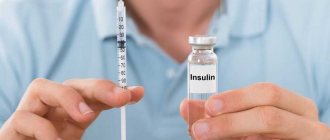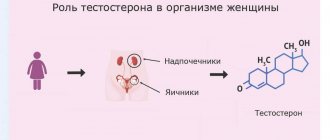Information about blood sugar and insulin
One of your body's energy sources is a type of sugar called glucose. Glucose is found in the foods you eat. The blood carries glucose to all cells of the body, supplying them with energy.
Insulin is a hormone that helps move sugar from the blood to other cells in the body. It is produced by the pancreas, an organ located at the back of the abdomen (belly).
If your pancreas does not produce enough insulin, your blood sugar levels will rise above normal. This happens because sugar stays in the blood instead of going into the cells. This condition is called high blood sugar (hyperglycemia). This may happen if you:
- diabetes mellitus type 1 or 2;
- the pancreas has been completely or partially removed;
- you are taking steroids such as prednisone or dexamethasone (Decadron®);
- fever (100.4°F (38°C) or higher), an infection, or you have recently had surgery.
Regulating blood sugar levels with insulin
If diabetes medications cannot control your blood sugar, you need to take insulin. You can only give insulin through injections (shots). The amount of insulin you need will depend on:
- blood sugar levels;
- your diet;
- your level of physical activity;
- your general health.
- other medications you are taking (such as steroids).
Measuring blood sugar levels
You can measure your blood sugar with a special device called a glucometer. Your doctor or diabetes educator will tell you what you should aim for. This will be an indicator for measurements on an empty stomach and the rest of the day. Checking your blood sugar level:
- warns you of high or low blood sugar levels;
- indicates whether your values are within acceptable limits;
- Helps you and your healthcare provider decide how much insulin is needed to keep your blood sugar levels within range.
Record all your blood sugar and insulin readings in a log book, a smartphone app, or just a piece of paper.
Blood Sugar Control
You will control your blood sugar levels on your own. You should:
- Adhere to the principles of a healthy diet without violating your eating regimen. Limit the amount of sweets you consume.
- Drink 6 to 8 8-ounce (240 ml) glasses of water or sugar-free, caffeine-free beverages daily unless your healthcare provider instructs you otherwise.
- Increase physical activity to the level recommended by your healthcare provider.
- Check your blood sugar as directed by your healthcare provider.
- Take diabetes medications or insulin as directed by your healthcare provider. Double-check your insulin dose before injecting.
- Visit your healthcare provider as directed.
We recommend that you order a MedicAlert® ID badge. It should state that you have diabetes and what type of insulin you need. For more information, call 888-633-4298 or visit www.medicalert.org.
to come back to the beginning
In recent years, more and more people are coming to appointments concerned about the results of their insulin blood test. Both its pronounced decrease and excess of the upper limit of reference values makes people suspect they have diabetes, go to doctors and again and again determine the level of insulin on an empty stomach and under load. The vast majority of these studies are done without indication and give rise to unfounded alarms, unnecessary follow-up examinations, and sometimes unwarranted treatment. Let's figure it out.
❓What is insulin?
Insulin is a hormone that helps glucose (in other words, sugar) get from the blood into cells (that is, lowers blood sugar levels). Glucose enters the blood from internal reserves (when we do not eat - for example, at night), as well as from food carbohydrates (that food that is broken down in the intestines into glucose and absorbed in this form into the blood), and the body's cells use it to obtain energy . The level of glucose in our blood is normally maintained within fairly narrow limits, regardless of whether we are fasting or overeating on cakes. Insulin and other hormones regulate the process so that sugar does not drop below normal (otherwise the brain will “turn off”) and does not rise above (otherwise the cells will suffer, diabetes and its complications will develop). Roughly speaking, if we are fasting or running marathons, or even just sleeping at night, then the body reduces the production of insulin, and if we eat a bun with jam, then the pancreas quickly releases into the blood the amount of insulin that is needed to absorb what comes from this bun and this glucose jam. When insulin production decreases or its action is impaired, diabetes mellitus develops. Read more about diabetes here
❓What is insulin resistance?
Insulin resistance is a decrease in the biological response to the action of insulin. That is, the tissues do not perceive it as well as normally, and more insulin is required for the penetration of glucose from the blood into the cells. If the pancreas is not able to produce this amount of insulin, then blood glucose begins to rise. This is one of the main mechanisms for the development of type 2 diabetes. Decreased sensitivity to insulin occurs very often (up to 1/3 of the adult population of the United States; there is no exact data for Russia). The vast majority of cases of insulin resistance are associated with central obesity, that is, with the accumulation of fat in the waist area. At the same time, the so-called metabolic syndrome, more about it here Insulin resistance is often found in polycystic ovary syndrome (even with normal body weight, and especially with excess weight), as well as with a history of gestational diabetes. Decreased insulin sensitivity is one of the main cardiovascular risk factors, since insulin resistance is often accompanied by increased blood pressure, the development of diabetes and atherosclerosis.
There are no accurate and readily available means of measuring insulin sensitivity, but this is usually not necessary. Measuring insulin levels is not required to make a diagnosis of metabolic syndrome. In order to give recommendations on weight loss for obesity, this is also not necessary. Sometimes we use insulin and glucose measurements with the HOMA index to determine the type of diabetes in unclear cases. The problem is that the topic of insulin resistance has now become very fashionable, especially among gynecologists, gynecologist-endocrinologists, gastroenterologists, Instagram healers and people interested in biohacking. Endocrinologists are also susceptible to this fashion. Everyone is prescribed to determine insulin levels, calculate the HOMA index, and even determine the level of glucose and insulin five times during a glucose load test (on an empty stomach and then every half hour).
As a result of such an examination, it is often possible to find a reason for fear. Here are typical questions that people ask during face-to-face meetings, on forums and in instant messengers:
❓“I (my child) have increased insulin levels! Sugar is normal. The examination was carried out regarding excess weight. Is this type 2 diabetes? Answer: No, this is not type 2 diabetes. Diabetes is a chronic increase in blood sugar levels above certain values. A normal fasting glucose level most likely indicates the absence of diabetes; additional tests can be performed using a glucose load test or determining the level of glycated hemoglobin. There is no need to look at insulin levels (many obese people will have elevated levels, and we know in advance that obese people are at risk of developing type 2 diabetes) to give weight loss advice. Next, you need to monitor not insulin, but blood sugar levels. Well, try to change your diet and physical activity, of course.
❓“I (my child) have too low insulin and C-peptide levels! The level of glucose and glycated hemoglobin is at the lower limit of normal. Is this the beginning of type 1 diabetes? Answer: normal levels of glucose and glycated hemoglobin exclude the diagnosis of diabetes mellitus (any type), and there was no reason to look at insulin and C-peptide. Low levels of insulin and C-peptide with normal glucose levels in children and young adults are the norm, and with underweight it is practically a pattern, and indicates good tissue sensitivity to insulin. In such cases, you should not do any more unnecessary examinations.
❓“My insulin levels are terribly increased after a carbohydrate load, although my glucose is normal! Is this diabetes? What to do?" Answer: calm down and understand that there are no norms for insulin levels during a test with 75 g of glucose, so the laboratory indicates “fasting” norms next to the result. A release of insulin occurs every time we drink juice or eat mashed potatoes, otherwise we would not be able to absorb the glucose that is absorbed after such a meal in the intestines. The purpose of measuring insulin after a glucose load is unclear.
❓“I have high insulin levels, and that's why I was prescribed metformin. I took a test a month later, but the insulin is still as high, why isn’t it going down?” Answer: the main indication for metformin is type 2 diabetes. You can easily verify this by reading the instructions. One of its mechanisms of action is improving insulin sensitivity; The benefits of its use have been proven mainly for patients with type 2 diabetes. It can also be used for prediabetes (when sugar is already higher than normal, but “does not reach” diabetic levels) and is sometimes used for polycystic ovary syndrome (although the basis for such recommendations is not so strong). But this is not a drug for lowering insulin levels, although often both the doctor and the patient are tempted to run tests. And this is not even a drug for the treatment of obesity, although due to its cheapness and safety, it is sometimes used for the purpose of reducing body weight under the motto “what if it helps.”
❤Don't get sick! ❤
Symptoms of low and high blood sugar
Elevated blood sugar (hyperglycemia)
Hyperglycemia occurs when your blood sugar levels rise above the normal limit. Elevated blood sugar can manifest itself in different ways, for example if you have:
- strong thirst;
- dry mouth;
- there is often a need to urinate, especially at night;
- strong feeling of hunger;
- blurred vision;
- drowsiness, weakness or fatigue.
Low blood sugar (hypoglycemia)
Hypoglycemia occurs when your blood sugar levels drop below 70 milligrams/deciliter (mg/dL). Low blood sugar can manifest itself in different ways, for example if you have:
- sweating;
- shiver;
- headache;
- feeling of faintness;
- rapid, increased heartbeat.
- weakness.
to come back to the beginning
Clinical manifestations
Symptoms of insulin are caused by hypoglycemia, which stimulates the secretion of catecholamines - adrenaline and norepinephrine, and entails a glucose deficiency in the brain, which is equivalent to a decrease in oxygen consumption by nerve cells [6].
The clinical picture includes two groups of symptoms - acute and chronic hypoglycemia. The period of acute hypoglycemia develops as a result of a breakdown in the adaptation mechanisms of the central nervous and endocrine systems. The main symptoms of this period: weakness, sweating, hunger, nausea, vomiting, irritability, blurred vision, blurred vision, numbness of the lips and tongue, palpitations, muscle tremors, pain in the heart, convulsive muscle twitching and even real convulsions.
.
Lack of glucose in the brain (neuroglycopenia) causes mental agitation, hallucinations, delusions, retrograde amnesia, aggressiveness, negativism, disorientation in faces, in time, in space, talkativeness, obscene expressions. There is a kind of switching off of the cerebral cortex, a “riot of the subcortex.” Far advanced hypoglycemia leads to the development of hypoglycemic coma .
Most often, acute hypoglycemia develops early in the morning (due to the overnight period of fasting), the patient either “cannot wake up” or wakes up with difficulty, and the above-mentioned clinical picture is revealed. Deep coma can lead to irreversible changes in the central nervous system (decerebration) and death. The period of chronic hypoglycemia (interictal period) is characterized by symptoms of chronic damage to the central nervous system: headaches, decreased memory, mental performance, constant feeling of hunger
(patients often eat, consume a lot of carbohydrates and gain weight), pathological Babinski reflexes, inappropriate behavior [7].
What to do if you have low blood sugar
If your blood sugar level drops below 70 mg/dL and you are awake and alert, follow the 15/15 rule:
- eat 15 grams of sugar;
- wait 15 minutes, then measure your blood sugar again.
Eat 15 grams of sugar
Select one of the options below:
- drink 4 ounces (120 ml) of fruit juice or regular soda;
- drink 8 ounces (240 ml) milk;
- eat 4 large marshmallow balls;
- eat 6-8 Life Savers® candies (not mints);
- Eat 3-4 large glucose tablets.
Don't eat chocolate or cookies if your blood sugar drops below 70 mg/dL.
Wait 15 minutes and then measure your blood sugar again
15 minutes after consuming 15 g of sugar, measure your blood sugar again.
If your sugar level is below 70 mg/dL when you retest, eat another 15 g of sugar. Take the measurement again after 15 minutes. Repeat these steps until your blood sugar levels rise to 70 mg/dL or higher.
When your sugar level rises to 70 mg/dL or higher, eat half a sandwich and drink 4 ounces (120 ml) of milk or juice. Or just eat normally.
You may need to switch to a different insulin or diabetes medication. Call your healthcare provider to discuss this.
to come back to the beginning
Diagnostics
At the first stage, the gold standard for diagnosing Harris syndrome is a not very humane test with fasting for 72 hours. It is considered positive in the development of Whipple's triad. The beginning of fasting is noted as the time of the last meal. Blood glucose levels are assessed 3 hours after the last meal, then every 6 hours, and if the blood glucose level drops below 3.4 mmol/l, the interval between tests is reduced to 30–60 minutes. The rate of insulin secretion in insulinoma is not inhibited by a decrease in blood glucose levels.
In addition, with insulinoma, the insulin/glycemic index (the ratio of insulin levels to glucose levels) exceeds 1.0, and normally is no more than 0.3. Also, with insulinoma, the concentration of C-peptide is sharply increased.
The second stage of diagnosing insulinoma is locating the tumor. Ultrasound, computed tomography, magnetic resonance imaging, endoscopic ultrasound, scintigraphy, angiography, and intraoperative ultrasound are used. The most informative methods for diagnosing insulin are endoscopic ultrasound (endo-ultrasound) and blood sampling from the hepatic veins after intra-arterial stimulation of the pancreas with calcium. With the help of modern research methods, it is possible at the preoperative stage in many patients to establish the location of the tumor, its size, stage and rate of progression, and identify metastases.
When should you contact your healthcare provider?
Call your healthcare provider if you have:
- temperature 100.4°F (38°C) or higher;
- chills;
- burning sensation or pain when urinating;
- the dose of steroid medications you are taking is increased, decreased, or stopped;
- signs of high or low blood sugar do not go away;
- There are often cases of increased or decreased blood sugar levels;
- your blood sugar level has risen to 200 mg/dL or higher;
- blood sugar levels reached 300 mg/dL twice in one day;
- Blood sugar levels drop to 70 mg/dL or lower. Before calling your healthcare provider, follow the 15/15 rule for normalizing low blood sugar, described in the “What to do if you have low blood sugar” section of this resource. When your sugar level reaches 70 mg/dL or higher again, call your healthcare provider.
to come back to the beginning
Information about the insulin used
Listed below are the types of insulin used at Memorial Sloan Kettering (MSK).
| Type | Name | Start of action | Maximum action | Duration of action |
| Fast acting | Aspart (NovoLog®) | 5–15 minutes | 30–60 minutes | 3–4 hours |
| Lispro (Humalog®) | 5–15 minutes | 60–90 minutes | 3–4 hours | |
| Fast acting | Novolin® R Regular | 30–60 minutes | 2–5 hours | 6–8 hours |
| Humulin® R Regular | 30–60 minutes | 2–4 hours | 6–8 hours | |
| Medium action | Novolin® N (NPH) | 1–2 hours | 6–12 hours | 12–14 hours |
| Humulin® N (NPH) | 1–2 hours | 6–12 hours | 12–16 hours | |
| Long-lasting | Glargine (Lantus®) | 1–2 hours | No maximum action time | Up to 24 hours |
| 1–2 injections of Detemir (Levemir®) daily | 1–2 hours | No maximum action time | Up to 24 hours | |
| Combined fast and medium action | NovoLog® Mix 70/30 (N/Aspart) | 30 minutes | 1–12 hours | 5–18 hours |
| Novolin® 70/30 (N+R) | 30–60 minutes | 4–12 hours | 14–16 hours | |
| Humalog® Mix 75/25™ (N/Lispro) | 5–15 minutes | 1–12 hours | 14–18 hours |
to come back to the beginning
